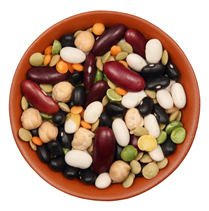
There are many ways to fill your grocery cart with nutritious foods that cost less. Focus on whole food instead of convenience food and prepare tasty homemade meals from scratch.
Over time, you’ll see your savings grow along with a healthier family. Get started by taking a look at these key focuses.
Save Money and Eat Well!
It’s easy to get into the habit of thrifty shopping. Lean meat, bread, and rolls can be purchased on sale and frozen for later use. To find the best value, always compare unit price stickers on different brands of the same food. Choose the food that has the lowest price per unit to save money. Only use coupons on essential foods that you had planned to purchase. Be sure that the price of the food purchased with a coupon is as good a value as the generic brand of the same item.
Below are some tips that you can use to stock up on nutritious foods while keeping more money in the bank.
Fruits and Vegetables
- Buy fresh fruits and vegetables that are in season because they will have the best flavor and cost less. To learn what is in season throughout the year, speak to your grocer in the produce section of your supermarket or visit your local farmer’s market. To learn more about the benefits of buying in season and local see How to Get the Most from Your Farmer’s Market, “local” is the new “organic.”, or farmers’ market.
- Stock up on store brand frozen and canned (low sodium when possible) vegetables when they are on sale. Purchase frozen vegetables without sauces. Canned vegetables are easiest to store. Keep several varieties on hand so that you will always have a vegetable to serve, even if you run out of fresh or frozen.
- Buy generic or store brand canned fruit in its own juices with no added sugar or syrup. Buy frozen fruit like mango, pineapple or berries and defrost the desired serving size in a covered bowl the day or night before. Always defrost fruit in the refrigerator, not on the kitchen counter. Pass up single-serving cups of fruit unless they are a real bargain. These generally cost more per serving than fruit from a larger can.
Whole Grains
- Choose whole grain bread, English muffins, bagels, and tortillas. See Where to Find Fiber to learn more about whole grains.
- Brown rice is more nutritious than white rice as it’s loaded with antioxidants, thiamine, niacin, potassium, vitamin E and fiber. It’s usually most economical when purchased in a larger bag. According to the USA Rice Federation, brown rice will stay fresh in your cupboard for about 6 months. Freeze or refrigerate rice that you will not use in that time. Visit https://thinkrice.com to find recipes and learn more about using brown rice.
- Plain oatmeal is an inexpensive whole grain that can be prepared quickly in the microwave. Top this with raisins and cinnamon or bananas and canned peaches for a tasty treat. Individual packets of flavored oatmeal have added sugar, more calories, and cost more. For great breakfast tips see Family Fun Breakfast.
Dry Beans
- Using dry beans as a substitute for meat is a great money saver. Lentil loaf made with lentils, eggs, low-fat cheese, and veggies is a tasty and inexpensive alternative to meatloaf. Plus, it’s packed with fiber and phytonutrients that will help to keep your family healthy and prevent disease.
Non-fat or Low-fat Dairy Foods
- Generic or store-brand non-fat canned evaporated milk is a smart substitute for cream or half-and-half used in sauces, cream soups or custard.
- Buy low-fat yogurt in quart containers and portion it into smaller reusable cups. Flavor plain yogurt with applesauce, fresh, canned, or partially thawed frozen fruit to get more yogurt for your money. This is a healthier option than buying fruit-flavored yogurts that have added table sugar. Blend your favorite frozen fruit and yogurt together for a tasty smoothie. Don’t forget to sprinkle on a little cinnamon for added taste and an antioxidant boost.
Shopping wisely can save you money with an added bonus of better nutrition for your family. Ready to get started on your healthy shopping list? See our Grocery Shopping Tips for more great ideas! Then learn how the average family of 4 in America throws away over $1300 in food annually and how you can prevent it in your family.












